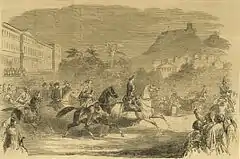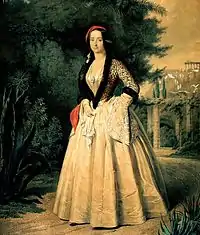Amalia of Oldenburg
Amalia of Oldenburg (Greek: Αμαλία; 21 December 1818 – 20 May 1875) was Queen of Greece from 1836 to 1862 as the spouse of King Otto (1815–1867). She acted as Regent of Greece in 1850-1851 when Otto was in Germany,[1] and a second time when he visited Bavaria in 1861-62.[2]
| Amalia of Oldenburg | |||||
|---|---|---|---|---|---|
 Portrait by Joseph Karl Stieler | |||||
| Queen consort of Greece | |||||
| Tenure | 22 December 1836 – 23 October 1862 | ||||
| Born | 21 December 1818 Oldenburg, Grand Duchy of Oldenburg | ||||
| Died | 20 May 1875 (aged 56) Bamberg, Kingdom of Bavaria | ||||
| Burial | |||||
| Spouse | |||||
| |||||
| House | Holstein-Gottorp | ||||
| Father | Augustus, Grand Duke of Oldenburg | ||||
| Mother | Princess Adelheid of Anhalt-Bernburg-Schaumburg-Hoym | ||||
| Religion | Lutheranism | ||||
As the daughter of Duke Paul Frederick Augustus of Oldenburg (later Grand Duke of Oldenburg) and Princess Adelheid of Anhalt-Bernburg-Schaumburg-Hoym. She was born a Duchess of Oldenburg, though that title was never used in Greece.
When she arrived in Greece in 1837, she at first won the hearts of the Greeks with her refreshing beauty. After the Queen became more politically involved, however, she became the target of harsh attacks — and her image suffered further as she proved unable to provide an heir. She and her husband were expelled from Greece in 1862, after an uprising. She spent the rest of her years in exile in Bavaria.
Early life
Duchess Amalia Maria Frederica was born on 21 December 1818 in Oldenburg, capital of the Grand Duchy of Oldenburg. She was the first child of Duke Paul Frederick Augustus of Oldenburg (later Grand Duke of Oldenburg) and his first wife, Princess Adelheid of Anhalt-Bernburg-Schaumburg-Hoym. She was less than two years old when her mother died, on 13 September 1820.
Marriage
On 22 December 1836, Duchess Amalia of Oldenburg married King Otto of Greece in Oldenburg. Born as the second son of King Ludwig I of Bavaria, Prince Otto of Bavaria had been appointed king of the newly created Kingdom of Greece in 1833. Otto visited Germany to find a bride after had been declared of legal majority, and met Amalia in Marienbad in Bohemia.
Amalia was Lutheran and Otto Catholic, and they were wed in both a Lutheran and Catholic wedding ceremony. It was an understanding, that while they were allowed to keep their religion, any child born to them would be raised in the Orthodox religion of Greece. On 14 February 1837, she arrived in Athens in Greece.
Queen of Greece


In the early years of the new monarchy, queen Amalia, with her beauty and vivaciousness, brought a spirit of smart fashion and progress to the impoverished country. She laboured actively towards social improvement and the creation of gardens in Athens, and at first won the hearts of the Greeks with her refreshing beauty and the patriotic love she demonstrated for her new home country. She was also the first to introduce the Christmas tree to Greece.
During her first years in Greece, Athens was still a small town and the king and queen resided in a relatively small house while the Old Royal Palace was being built. With few exceptions such as Katerina Botsari, the Royal Household was made up of Germans.[3] Queen Amalia loved to dance and ride,[4] arranged balls at court and could be seen riding in and around Athens, leasure activities which was common for upper class women in Western Europe but new in Greece, were women had normally lived in seclusion during the Ottoman Empire.
Queen Amalia founded the National Gardens of Athens in 1839, and the orphanage in Amaléion 1855.
The town of Amaliada in Elis, and the village of Amaliapolis in Magnesia, were named for the Queen.
Succession crisis and political activity
As King Otto and his Bavarian advisers became more enmeshed in political struggles with Greek political forces, the Queen became more politically involved, also. She became the target of harsh attacks when she became involved in politics - and her image suffered further as she proved unable to provide an heir. She also remained a Protestant in an almost universally Orthodox country, throughout her husband's reign.
Initially, her Lutheran religion was not given much attention, but the aversion to it grew when she did not give birth to a child which could be raised Orthodox. One of the biggest crisis of Ottos reign, as well as Amalia's impopularity, was the succession crisis. The cause of the childlessness of Otto and Amalia has been the cause of debate. During this time period, infertility were commonly considered the fault of the woman, and Amalia's frequent dancing and riding were blamed for it.[4] She was exposed to various fertility treatment until her 35th birthday. Otto's brothers were given the right to the throne after him, but it was rumoured that queen Amalia wished to have her brother Elimar of Oldenburg appointed heir instead.
In connection to this, the queen were given more political importance. Amalia was given the right to govern as regent in the case of the absence or incapability of the monarch or the heir to the throne.[5] She acted as Regent of Greece in 1850-1851 when Otto was in Germany for health reasons,[6] and a second time in 1862-1861, when Otto visited his family in Bavaria to discuss the succession crisis.[7]
Her political influence were controversial. Her favorites were considered to have influence over her, notably her principal lady-in-waiting Baroness Wilhelmine von Plüskow was widely rumored to influence state affairs, particularly in matters relating to Austria, through both the queen and the king, which exposed her to controversy.[8]
Fashion influence (Amalia dress)


When she arrived in Greece as a queen in 1837, she had an immediate impact on social life and fashion. She realized that her attire ought to emulate that of her new people, and so she created a romantic folksy court dress, which became a national Greek costume still known as the Amalía dress.[9]
It follows the Biedermeier style, with a loose-fitting, white cotton or silk shirt, often decorated with lace at the neck and cuffs, over which a richly embroidered jacket or vest is worn, usually of dark blue or claret velvet. The skirt was ankle-length, unpressed-pleated silk, the color usually azure. It was completed with a soft cap or fez with a single, long, golden silk tassel, traditionally worn by married women, or with the kalpaki (a toque) of the unmarried woman, and sometimes with a black veil for church. This dress became the usual attire of all Christian townswomen in both Ottoman Empire-occupied and liberated Balkan lands as far north as Belgrade.
Assassination attempt
In February 1861, a university student named Aristeidis Dosios (son of politician Konstantinos Dosios)[10] unsuccessfully attempted to assassinate the Queen. He was sentenced to death, but the Queen intervened, and he was pardoned and sentenced to life imprisonment. He was hailed as a hero for his attempt by certain factions, but the attempt also provoked among the people spontaneous feelings of sympathy towards the royal couple.
Expulsion

Just over a year later, an uprising took place in Athens while the royal couple were on a visit to the Peloponnese. The Great Powers, who had supported Otto, urged them not to resist, and Otto's reign came to an end. They left Greece aboard a British warship, with the Greek royal regalia that they had brought with them. It was reported in the press that all their courtiers were left unmolested with the exception of the queen's controversial favorite Wilhelmine von Plüskow, who was exposed to sarcasm from the crowd when she left.[11]
It has been suggested that the King would not have been overthrown had Amalia borne an heir, as succession was also a major unresolved question at the time of uprising.[12] It is also true, however, that the Constitution of 1843 made provision for Otto to be succeeded by his two younger brothers and their descendants.
Exile
King Otto and Queen Amalia spent the rest of their years in exile, at home in Bavaria. They decided to speak Greek each day between 6 and 8 o'clock to remember their time in Greece.
Death
King Otto died in 1867. Queen Amalia survived her husband by almost eight years and died in Bamberg on 20 May 1875. She was buried beside the king at the Theatinerkirche in Munich.
The cause of the royal couple's infertility remained contested even after an autopsy was performed on the queen.[13]
| Styles of Queen Amalia of the Greeks | |
|---|---|
 | |
| Reference style | Her Majesty |
| Spoken style | Your Majesty |
Titles
- 21 December 1818 – 20 May 1875: Her Highness Duchess Amalie of Oldenburg, Princess of Holstein-Gottorp
- 22 December 1836 – 23 October 1862: Her Majesty The Queen of Greece
- 23 October 1862 – 20 May 1875: Her Majesty Queen Amalia of Greece
References
| Wikimedia Commons has media related to Queen Amalia of Greece. |
- Édouard Driault et Michel Lhéritier, Histoire diplomatique de la Grèce de 1821 à nos jours : Le Règne de Georges Ier avant le traité de Berlin (1862-1878) - Hellénisme et slavisme, t. III, PUF, 1926
- Leonard Bower, Otho I : King of Greece, a biography, Royalty Digest, 2001 (ISBN 1905159129)
- Leonard Bower, Otho I : King of Greece, a biography, Royalty Digest, 2001 (ISBN 1905159129)
- Lüth C. Fra Fredensborg til Athen: Fragment af en Kvindes Liv. Copenhagen; Gyldendalske;1926.
- Robert Phillimore:Commentaries Upon International Law
- Édouard Driault et Michel Lhéritier, Histoire diplomatique de la Grèce de 1821 à nos jours : Le Règne de Georges Ier avant le traité de Berlin (1862-1878) - Hellénisme et slavisme, t. III, PUF, 1926
- Leonard Bower, Otho I : King of Greece, a biography, Royalty Digest, 2001 (ISBN 1905159129)
- Marysville Daily Appeal, Number 14, 17 January 1863
- "Archived copy". Archived from the original on 2016-10-10. Retrieved 2014-03-31.CS1 maint: archived copy as title (link) National Costume of Greece
- Brekis, Spyros, L Ph.D.; Ίστορια της Νεωτέρας Ελλάδος (History of Modern Greece) (in Greek) (2003)
- Marysville Daily Appeal, Number 14, 17 January 1863
- John Van der Kiste, Kings of the Hellenes (Sutton Publishing, 1994) ISBN 0-7509-2147-1
- The infertility of the first royal couple of Greece (1833–1862)
- Brekis, Spyros L. Ph.D.; Ιστορια της Νεωτερας Ελλαδος (History of Modern Greece) (in Greek) (coursebook in the 'History of Modern Greece' course of the University of Athens)
- Zaoussis, Alexander L.; Αμαλια και Οθων (Amalia and Othon) (in Greek) Okeanida, 2002. ISBN 960-410-254-0 </references>
External links
| Wikisource has the text of an 1879 American Cyclopædia article about Amalia of Oldenburg. |
- Greek royal tombs
- "The Costume in 1800s". www.annaswebart.com. Archived from the original on 2008-01-26. Retrieved 2008-06-11.
- . New International Encyclopedia. 1905.
Amalia of Oldenburg Born: 21 December 1818 Died: 20 May 1875 | ||
| Greek royalty | ||
|---|---|---|
| Preceded by None |
Queen consort of Greece 22 December 1836 – 23 October 1862 |
Succeeded by Olga Constantinovna of Russia |